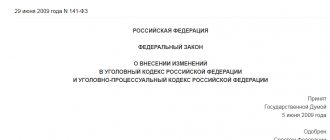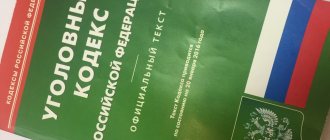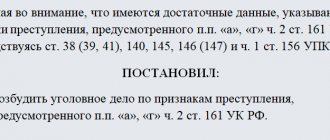The concept and forms of completing a preliminary investigation
The essence of the end of the preliminary investigation is that the investigator sums up his work in investigating the crime, evaluates the collected evidence from the point of view of the completeness and comprehensiveness of the study of all the circumstances of the committed act and the sufficiency of the evidence to make a final decision on the case. Having recognized that the preliminary investigation has been carried out comprehensively and completely, all planned versions have been verified and all circumstances to be proven have been established, the investigator makes a decision to end the investigation.
The preliminary investigation can be completed in one of the following forms: 1) drawing up an indictment; 2) drawing up a resolution to terminate the criminal case; 3) drawing up a resolution to send the case to court for the application of a compulsory measure of a medical nature.
The structure of completing a preliminary investigation in any of these forms should consist of the following procedural actions:
- assessment of the evidence collected in the case from the point of view of its sufficiency to form a reliable conclusion about the possibility and form of completing the investigation;
- systematization of criminal case materials;
- announcement to the participants in the process that the collection of evidence has been completed and clarification of their right to familiarize themselves with the case materials;
- consideration and resolution of the petitions they made when familiarizing themselves with the case materials;
- presentation of additional materials to the participants in the process if they appeared as a result of the satisfaction of the petitions;
- drawing up a final document that completes the investigation of the case.
Components of the annex to the indictment
As noted earlier, the appendix to the document is an important part, which is why it is necessary to know its components more specifically and completely. In accordance with the law, the following must be attached to the indictment:
- Information about the specific dates of the investigation.
- Information about the preventive measures chosen by the official. In this case, the time of their implementation is specifically indicated.
- Certificate of physical evidence - listing their names, quantity and serial number in the inventory.
- Certificate of civil claim, if any (if material or moral damage is compensated).
- A certificate of measures taken by the official to preserve property and ensure punishment in the form of a fine.
Termination of a criminal case: grounds and procedural order
Termination of a criminal case is a form of ending the preliminary investigation, in which the investigator completes the criminal proceedings by his decision without subsequently sending the case to court.
An investigation into a criminal case is terminated if, as a result, circumstances have been established that exclude the possibility or necessity of further proceedings in the case. Justified and timely termination of a criminal case protects an innocent person from being brought to criminal liability or excludes the application of criminal punishment to those persons who do not pose a great public danger due to the insignificance of the committed act and subsequent reconciliation with the victim, active repentance or other circumstances provided for by law.
The Criminal Procedure Law provides an exhaustive list of grounds for termination of a criminal case (Article 212 of the Criminal Procedure Code). The preliminary investigation is terminated:
- if there are circumstances that exclude proceedings in the case (Article 24, paragraphs 3–8, Part 1, Article 27 of the Criminal Procedure Code);
- the non-involvement of the suspect or accused in the commission of a crime has been established (clause 1, part 1, article 27 of the Criminal Procedure Code);
- there are circumstances that allow the investigator and inquiry officer, with the consent of the prosecutor, to release a person from criminal liability (Articles 25, 26, 28 of the Criminal Procedure Code).
Grounds for termination of the criminal case provided for in clauses 1, 2, part 1 of Art. 24 (absence of a crime and absence of corpus delicti in the act) and paragraph 1 of Part 1 of Art. 27 of the Criminal Procedure Code (non-involvement of the suspect or accused in the commission of a crime) are rehabilitative and mean a recognition of the person’s innocence of committing a crime. If the case is terminated on these grounds, the investigator or prosecutor takes the measures provided for by the Criminal Procedure Code to rehabilitate the person and compensate for the harm caused to him as a result of criminal prosecution (Part 2 of Article 212 of the Criminal Procedure Code).
The procedure for terminating a criminal case is established by Art. 213 of the Criminal Procedure Code. The case is terminated by order of the investigator, a copy of which is sent to the prosecutor. The resolution states:
- date and place of its preparation;
- position, surname and initials of the investigator;
- the circumstances that served as the reason and basis for initiating a criminal case;
- clause, part, article of the Criminal Code, providing for the crime on the basis of which a criminal case was initiated;
- the results of the preliminary investigation indicating information about the persons against whom criminal prosecution was carried out;
- the preventive measures used;
- clause, part, article of the Code of Criminal Procedure on the basis of which the criminal case is terminated;
- a decision to cancel the preventive measure, as well as the seizure of property, correspondence, temporary removal from office, control and recording of negotiations;
- decision on physical evidence;
- procedure for appealing this decision.
Termination of a criminal case due to the expiration of the statute of limitations for criminal prosecution; due to the absence of a court conclusion on the presence of signs of a crime or due to the lack of consent of the Federation Council, the State Duma, the Constitutional Court of the Russian Federation, the qualification board of judges to initiate a criminal case or involve as an accused a circle of persons established by law (clause 3.6 of Part. 1 Article 24 of the Criminal Procedure Code); in connection with the reconciliation of the parties; in connection with active repentance (Articles 25, 28 of the Criminal Procedure Code), as well as in connection with an act of amnesty or refusal of the Federation Council or State Duma to give consent to the deprivation of immunity of persons established by law (Clause 3, 6 Part 1 of Art. 27 of the Criminal Procedure Code) is allowed only with the consent of the accused.
The investigator hands or sends a copy of the decision to terminate the criminal case to the person against whom the criminal prosecution has been terminated, the victim, the civil plaintiff and the civil defendant. At the same time, the victim, the civil plaintiff, is explained the right to bring a claim in civil proceedings if the case is terminated on the grounds provided for in paragraphs 2–6 of Part 1 of Art. 24, art. 25, paragraph 2–6, part 1, art. 27, 28 of the Criminal Procedure Code.
In cases where there are several accused in a criminal case, and criminal prosecution is terminated only against one of them, the investigator, in accordance with Art. 27 of the Criminal Procedure Code makes a decision to terminate criminal prosecution against this accused.
Having recognized the investigator's decision to terminate a criminal case or criminal prosecution as illegal or unfounded, the prosecutor submits a reasoned resolution to forward the relevant materials to the head of the investigative body to resolve the issue of canceling the decision to terminate the criminal case. Having recognized the investigator's decision to terminate a criminal case or criminal prosecution as illegal or unfounded, the prosecutor cancels it and resumes the criminal proceedings. Having recognized the investigator's decision to terminate the criminal case or criminal prosecution as illegal or unfounded, the head of the investigative body cancels it and resumes the criminal proceedings.
If the court recognizes the investigator’s decision to terminate a criminal case or criminal prosecution as illegal or unfounded, then it makes an appropriate decision and sends it to the head of the investigative body for execution.
Resumption of proceedings on a previously terminated case may take place in accordance with the emergence of new or newly discovered circumstances, but only if the statute of limitations for bringing a person to criminal liability has not expired.
The decision to resume criminal proceedings is communicated to the accused, his defense attorney, the victim, his representative, the civil plaintiff, the civil defendant or their representatives, as well as the prosecutor.
Introduction…………………………………………………………………………………..2
1. Indictment
1.1. Concept of indictment …………………………………………………3
1.2. Contents of the indictment …………………………………4
1.3 Actions and decisions of the prosecutor in the case received with an indictment………………………………………………………………………8
2. Indictment
2.1. Concept and content of the indictment …………………………..11
2.2. The decision of the prosecutor in a criminal case received with an indictment …………………………………………………………………………….12
Conclusion…………………………………………………………………………………13
List of references………………………………………………………..14.
Introduction
The preliminary investigation of a criminal case has two independent forms: inquiry and preliminary investigation. Inquiry is the primary form of investigation for cases in which a preliminary investigation is mandatory, and the main form of investigation for simple cases in which a preliminary investigation is not necessary.
Preliminary investigation, as a special type of state activity of specially authorized persons (investigators), proceeding in the form established by law and aimed at fulfilling the tasks of this stage of the criminal process, is the main form of investigation.
At the end of the inquiry, the investigator draws up an indictment. An indictment is an act of preliminary investigation, in which the results of the preliminary investigation are summed up, incriminating conclusions are drawn, which were reached by the investigator on the basis of a comprehensive, complete and extensive study of the circumstances of the case.
The indictment and the indictment, the concept and content, similarities and differences - these are the main issues of this work.
During the work, the following tasks were solved:
-studied the concept of indictment and indictment:
- the contents of the indictment and the indictment were considered, and a comparative analysis of the indictment and the indictment was carried out;
- the results of the studies are summarized and conclusions are drawn.
1. Indictment
1.1. Concept of indictment
The work of the investigator to investigate the circumstances of a criminal case ends with the drawing up of an indictment. This procedural act formulates the essence of a specific criminal case and the accusation, the investigator’s conclusions about the commission of a certain criminal offense by the accused and the need to send the criminal case to court.
An indictment is an act of preliminary investigation, in which the results of the preliminary investigation are summed up, incriminating conclusions are drawn, which were reached by the investigator on the basis of a comprehensive, complete and extensive study of the circumstances of the criminal case[1].
The indictment has important legal significance. It defines the limits of judicial proceedings, both in relation to the persons and the subject of the accusation. This procedural act allows the accused to prepare in a timely manner to participate in the trial.
Its significance lies in the fact that it systematizes all the materials of the preliminary investigation of a criminal case and determines the limits of the trial.
The announcement of the indictment or its operative part at the beginning of the judicial investigation allows the composition of the court, the participants in the process, as well as persons present at the trial, to understand the essence of the charge brought forward, which will be the subject of the trial[2].
1.2. Contents of the indictment
Regardless of the number of accused, only one indictment is drawn up for each criminal case. The indictment must contain the wording of the charges. It provides evidence confirming the occurrence of the crime and the guilt of the person in committing it. This procedural act is served on the accused after the trial has been scheduled. The judicial investigation begins with the announcement of the indictment[3].
The indictment begins with the surname, name and patronymic of the accused, the article of the criminal law under which the crime is qualified. The indictment consists of a descriptive and operative part.
The descriptive part sets out: the essence of the case (the place and time of the crime, its methods, motives, consequences and other significant circumstances); information about the victim; evidence that confirms the existence of a crime and the guilt of the accused; circumstances mitigating and aggravating his responsibility; the arguments put forward by the accused in his defense and the results of testing these arguments. The indictment must contain references to the case sheets.
The essence of the case is a description of the circumstances of the crime committed in accordance with a certain subject of proof in a criminal case[4]. The basis of this description is the charge formulated in the decision to bring the person as an accused.
Information about the victim includes his last name, first name and patronymic, time and place of birth, place of work (service) and other information about his personality that is important for resolving the case. When presenting evidence that confirms the commission of a crime and the guilt of the accused, the investigator cannot limit himself to just listing the sources of relevant information, but is obliged to present the factual data contained in these sources with references to the sheets of the case[5].
The presentation of evidence usually begins with the testimony of the accused. It is indicated whether the accused pleaded guilty and what factual data he provided. By disclosing the content of his testimony, the investigator has no right to violate the rule that the accused is not obliged to prove his innocence.
Then the indictment provides the contents of the testimony of the victim, witnesses, expert opinions, investigative reports and other documents, and indicates material evidence. After presenting the evidence, the circumstances mitigating and aggravating the responsibility of the accused, as well as other circumstances characterizing his personality, are set out.
The operative part of the indictment contains: information about the identity of the accused, the wording of the charge, indicating the article or articles of the criminal law providing for this crime.
Information about the identity of the accused includes: last name, first name, patronymic, time and place of birth, nationality, citizenship, place of work (service), marital status, information about the presence or absence of a criminal record of the accused person, information about his awards, his place of residence , as well as other data relevant to the case.
The formulation of the charge contains a statement of the factual circumstances of the case, after which the legal qualification of the act by the accused is given. It must reflect all the qualifying elements of a crime in accordance with the actual circumstances of the criminal case[6].
If the accused is charged with committing several crimes falling under several articles of the criminal law, the wording of the charge must indicate what specific actions the accused is charged with under each article of the criminal law.
When a crime is committed by several persons, the formulation of the charge is given in relation to each accused.
The indictment is signed by the investigator, indicating the time and place of its preparation.
Attached to the indictment are: a list of persons subject, in the opinion of the investigator, to being summoned to appear in court, as well as information about the duration of the investigation, about the chosen preventive measures indicating the time of detention, about material evidence, about the civil claim, about the measures taken to secure the civil claim and possible confiscation of property, legal costs.
The list of persons to be summoned to the court session shall indicate the surname, name and patronymic of the accused, victim, civil plaintiff, civil defendant, representatives, witnesses, experts, specialists, translators, their place of residence or location with keeping of the case sheets containing their testimony or conclusion.
The certificate on the duration of the investigation must contain the dates of the commission of the crime; initiating a criminal case and accepting it for preliminary investigation; bringing charges; familiarization of the participants in the process with the case materials[7].
The certificate of chosen preventive measures indicates the type of preventive measure chosen and the date of its application. When choosing detention, it is necessary to indicate the exact time of the accused’s stay in the place of pre-trial detention, taking into account the extension of the period of detention.
A certificate of material evidence contains a list of material evidence indicating the places of their storage. This certificate should contain references to the sheets of the case, which contain protocols of investigative actions during which material evidence was discovered and seized.
The certificate of civil claim indicates when, by whom, against whom, and for what amount the civil claim was filed. In this case, precise information is provided about the civil plaintiff and the civil defendant, as well as the amount of material damage subject to compensation.
A certificate of measures taken to secure a civil claim and possible confiscation of property includes an indication of whose property is seized, for what amount, as well as the location of storage of this property. If the seizure was imposed on a large number of items, then the total value of the seized property is indicated.
The certificate of legal costs contains the corresponding amounts determined in accordance with the requirements of the law.
The indictment may be accompanied by certificates not directly provided for by the criminal procedure law: about confiscated orders and medals, about measures taken to care for children and about the protection of the property of the accused, about measures taken to eliminate the causes and conditions that contributed to the commission of the crime, etc. [8]
Attachments to the indictment are signed by the investigator. After signing the indictment, the investigator immediately forwards the case to the prosecutor.
1.3 Actions and decisions of the prosecutor in a case received from
indictment
After receiving a criminal case with an indictment from the investigator, the prosecutor (prosecutor) is obliged to once again check all the materials of the criminal case and answer the following questions:
-whether evidence has been collected in accordance with the procedure established by law to confirm that the criminal act charged to the accused took place;
-whether it contains elements of a crime;
- are there any circumstances leading to the termination of criminal proceedings;
— whether the preliminary investigation was carried out in compliance with the requirements of comprehensiveness, completeness and objectivity;
— whether the accusation is justified by the evidence collected in the case;
-whether charges have been brought for all crimes;
-whether all persons convicted of committing this crime have been brought as defendants;
-whether the criminal act is classified correctly;
-whether the preventive measure was chosen correctly;
- have measures been taken to secure a civil claim and. possible confiscation of property;
- have the causes and conditions that contributed to the commission of the crime been identified, and have the necessary measures been taken to eliminate them?
— whether all requirements of the criminal procedure law were observed during the investigation;
-whether the indictment itself was drawn up correctly (Article 213 of the Code of Criminal Procedure)[9].
The prosecutor or his deputy is obliged, within a period of no more than five days, to consider the received criminal case and make one of the following decisions on it[10]:
1) on approval of the indictment;
2) to return the case to the body of inquiry or preliminary investigation with its written instructions to conduct an additional investigation in this criminal case;
3) on termination of the criminal case;
4) on initiating a criminal case with written instructions to the investigator or investigative body to re-draft the indictment;
5) draw up a new indictment, and remove the previously drawn up one from the case and return it to the investigating authorities or the investigator, indicating the irregularities found in it.
The prosecutor or his deputy also has the right to exclude certain charges from the indictment and apply the law on a less serious crime.
If it is necessary to change the charge in a criminal case to a more serious one or significantly different from the original one, the case is returned to the investigator for filing a new charge.
The prosecutor or his deputy has the right to change the previously chosen preventive measure, or to choose a preventive measure if there was none. In case of cancellation, change or selection of a preventive measure in the form of detention, the rules established by Art. 96 Code of Criminal Procedure of the Russian Federation. The prosecutor or his deputy also has the right to make changes to the list of persons subject to summons to court (Article 216 of the Code of Criminal Procedure of the Russian Federation)[11].
In addition, the list of persons to be summoned to the court hearing attached to the indictment may be changed.
If the case falls within the jurisdiction of a higher court, then, for example, the district prosecutor does not approve the indictment, but sends the case to a higher prosecutor, who checks compliance with the laws during the investigation of this criminal case in the lower prosecutor's office, and if he believes that the case can be sent to court, then approves the indictment and sends it to the court, while simultaneously indicating which prosecutor will support the charge in court.
If the accused does not speak the language in which the preliminary investigation was conducted, the prosecutor must provide a translation, with the help of an interpreter, of the indictment into a language that the accused speaks.
If the indictment is not approved by the prosecutor, the criminal case is returned for additional investigation due to a significant violation of the criminal procedure law.
Having approved the indictment, the prosecutor or deputy sends the case to the court that has jurisdiction over it and notifies the accused about it. At the same time, he informs the court whether he considers it necessary to support the prosecution, after which all petitions and complaints are sent directly to the court (Article 217 of the Code of Criminal Procedure of the Russian Federation)[12].
2. Indictment
2.1. Concept and content of the indictment
At the end of the investigation, the investigator draws up an indictment, which indicates[13]:
1) date and place of its preparation;
2) position, surname, initials of the person who compiled it;
3) information about the person brought to criminal liability;
4) the place and time of the commission of the crime, its methods, motives, goals, consequences and other circumstances relevant to the given criminal case;
5) the wording of the charge indicating the paragraph, part, article of the Criminal Code of the Russian Federation;
6) a list of evidence supporting the accusation and a list of evidence referred to by the defense;
7) circumstances mitigating and aggravating punishment;
 information about the victim, the nature and extent of the harm caused;
information about the victim, the nature and extent of the harm caused;
9) list of persons subject to summons to court.
The accused and his defense attorney must be familiarized with the indictment and the materials of the criminal case, which is noted in the protocol of familiarization with the materials of the criminal case.
The victim or his representative, at his request, may be provided with the indictment and materials of the criminal case for review in the same manner as established by part two of this article for the accused and his defense attorney. The indictment drawn up by the inquiry officer is approved by the head of the inquiry body. The materials of the criminal case, together with the indictment, are sent to the prosecutor.
2.2. The decision of the prosecutor in a criminal case received from
indictment
The prosecutor considers the criminal case received with an indictment, and within 2 days makes one of the following decisions on it[14]:
1) on approval of the indictment and on sending the criminal case to court;
2) on the return of the criminal case for additional inquiry or re-drafting of the indictment if it does not comply with the requirements of Article 225 of the Code of Criminal Procedure of the Russian Federation with its written instructions. In this case, the prosecutor may extend the period of inquiry, but by no more than 10 days to conduct an additional inquiry and by no more than 3 days to re-draft the indictment;
3) on the termination of a criminal case on the grounds provided for in Articles 24 - 28 of the Criminal Procedure Code;
4) on sending a criminal case for preliminary investigation.
When approving the indictment, the prosecutor has the right, by his decision, to exclude from it certain counts of the charge or to reclassify the charge to a less serious one.
A copy of the indictment with attachments is handed over to the accused, his defense attorney and the victim in the manner prescribed by Article 222 of the Criminal Procedure Code.
Conclusion
In the vast majority of cases, consideration of a criminal case in court would be impossible without a preliminary investigation.
Preliminary investigation is the activity of the bodies of inquiry and the investigator to collect, verify and evaluate evidence, on the basis of which circumstances relevant to the case are established, in order to quickly and completely disclose the crime, expose and bring as an accused the person who committed it, and take preventive measures. crime, identifying and eliminating the causes and conditions that contributed to its commission, as well as measures to ensure compensation for damage caused by the crime.
Based on the results of the preliminary investigation, depending on the type of crime being investigated and the body conducting the investigation, an indictment or indictment is drawn up (investigator - charge, investigator - act).
Evidence obtained by the body of inquiry within the limits of the procedural powers granted to it has the same significance for the court as evidence collected by the investigator.
At the same time, there are certain differences between inquiry and investigation: in the range of cases assigned to the jurisdiction of each of them, in the timing of inquiry and investigation, and in some other procedural rules.
In this work, the concept and content of the indictment and the indictment, their similarities and differences were examined, the results of the study on this issue were summarized in a comparative table.
List of used literature
1.
Criminal Procedure Code of the Russian Federation of December 18, 2001 N 174-FZ (as amended on May 29, July 24, 25, October 31, 2002, June 30, July 4, 7, December 8, 2003, April 22 , June 29, 2004)
2.
Alekseeva L.B., etc. Criminal procedural law of the Russian Federation - M. 2004.
3.
Belozerov Yu.N., Efimichev S.P. Indictment in criminal proceedings. M., 2002.
4.
Commentary on the Criminal Procedure Code of the Russian Federation. Under general ed. IN AND. Radchenko. - M., 2005.
5.
Smirnov A.V., Kalinovsky K.B. Criminal process: Textbook for universities / Ed. ed. A. V. Smirnova. St. Petersburg: Peter, 2004. - 697 p. — (Series “Textbook for Universities”). 2nd ed. St. Petersburg: Peter, 2005.
6.
Criminal procedural law of the Russian Federation. Textbook. Rep. ed. P.A. Lupinskaya. - St. Petersburg: Peter, 2005
7.
Criminal process: Textbook / Ed. A.S. Koblikova. – M.: Norma – Infra-M, 2004.
[1] Alekseeva L.B., et al. Criminal procedural law of the Russian Federation - M. 2004.
[2] Smirnov A.V., Kalinovsky K.B. Criminal process: Textbook for universities / Ed. ed. A. V. Smirnova. St. Petersburg: Peter, 2004. - 697 p. — (Series “Textbook for Universities”). 2nd ed. St. Petersburg: Peter, 2005.
[3] Criminal Procedure Code of the Russian Federation of December 18, 2001 N 174-FZ (as amended on May 29, July 24, 25, October 31, 2002, June 30, July 4, 7, December 8, 2003 , April 22, June 29, 2004)
[4] Criminal procedural law of the Russian Federation. Textbook. Rep. ed. P.A. Lupinskaya. - St. Petersburg: Peter, 2005
[5] Criminal Procedure Code of the Russian Federation of December 18, 2001 N 174-FZ (as amended on May 29, July 24, 25, October 31, 2002, June 30, July 4, 7, December 8, 2003 , April 22, June 29, 2004)
[6] Commentary on the Criminal Procedure Code of the Russian Federation. Under general ed. IN AND. Radchenko.- M., 2005
[7] Criminal procedure: Textbook / Ed. A.S. Koblikova. – M.: Norma – Infra-M, 2004
[8] Alekseeva L.B., et al. Criminal procedural law of the Russian Federation - M. 2004.
[9] Alekseeva L.B., et al. Criminal procedural law of the Russian Federation - M. 2004.
[10] Smirnov A.V., Kalinovsky K.B. Criminal procedure: Textbook for universities / Ed. ed. A. V. Smirnova. St. Petersburg: Peter, 2004. - 697 p. — (Series “Textbook for Universities”). 2nd ed. St. Petersburg: Peter, 2005
[11] Criminal Procedure Code of the Russian Federation of December 18, 2001 N 174-FZ (as amended on June 29, 2004)
[12] Criminal Procedure Code of the Russian Federation of December 18, 2001 N 174-FZ (as amended on June 29, 2004)
[13] Belozerov Yu.N., Efimichev S.P. Indictment in criminal proceedings. M., 2002.
[14] Criminal Procedure Code of the Russian Federation of December 18, 2001 N 174-FZ (as amended on June 29, 2004), Art. 226
Tags: Indictment. Indictment Abstract Criminal trial
Legal nature of the indictment
If we take into account the meaning of clause 2, part 1, art. 47 of the Code of Criminal Procedure of the Russian Federation, the indictment is of enormous importance in the progress of the criminal case. It is from the moment the document is drawn up that a person changes the status of a suspect to the status of an accused. First of all, this gives rise to completely new rights and obligations of a person, which is called legal status. The law reserves the right of the accused and the defense attorney to carefully read the document and, if any comments or amendments arise, to ask the investigator to add them to the document. A separate document is also drawn up, in which all notes are made and the familiarization process is described. The law also provides for the right of the victim and his representative to file a petition to become familiar with the essence of the indictment and all documents included in the criminal case.
Checking the indictment by the prosecutor
After the indictment has been approved by the official - the head of the inquiry body, it, together with other materials of the prepared criminal case, is sent further to the prosecutor, because he is entrusted with the responsibility of monitoring the activities of the inquiry bodies. The prosecutor, in turn, must review and analyze the criminal case and the indictment for it within two days, and also, based on the results of the review, make one of the decisions established by the Code of Criminal Procedure of the Russian Federation, which we will note below.
Indictment and indictment: differences between documents
The indictment is the result of an abbreviated investigation, which is based on the available evidence and the confession of the accused. In turn, as we know, an indictment is a procedural document that completes the inquiry process in a general form.
- To issue an indictment, you only need to perform those procedural steps that, at the discretion of the investigator, are sufficient to bring charges.
- The terms of the shortened inquiry, as the name implies, are more compressed than in a regular inquiry.
Everything else, including design requirements, is the same.
Decisions made by the prosecutor during the consideration of the indictment
One of the activities of the prosecutor in the field of supervision is the consideration of the indictment and the decision of the prosecutor based on its results. This power is established by Art. 226 Code of Criminal Procedure of the Russian Federation. Based on the results of the consideration of the criminal case, the prosecutor may make any of the decisions noted below.
- Approval of the indictment by the prosecutor and preparation of case materials for sending to the court, where it is subsequently considered.
- Returning the materials of the criminal case to draw up a repeated, more complete indictment, which in the future will meet the requirements put forward. The law establishes a period for re-drafting - 3 days. An extremely important aspect of work in this direction are the recommendations and comments of the prosecutor, which he notes. In this case, he coordinates the work of police officers and helps them draw up documents correctly.
- Returning the criminal case so that the officer has the opportunity to conduct an additional investigation. In this case, the period for conducting such an inquiry should not exceed 10 days. Such a decision is made when the prosecutor sees that the interrogator has closed his eyes to some questions and has not paid attention to important details.
- Termination of proceedings only when there are grounds for this provided for by the Code of Criminal Procedure of the Russian Federation. The law has a separate article that describes cases of suspension and termination of an investigation in a specific case. If the prosecutor establishes the presence of one such fact, the case is terminated.
- Sending a package of documents, which includes materials from the criminal case, in order to begin another type of investigation, for example, a preliminary investigation.
If the indictment is reviewed and approved by an employee of the prosecutor's office, copies are given to the accused and his defense attorney.
Procedural meaning of the indictment
Based on all of the above, we can conclude that the indictment is the most important part of the investigator’s work. It is this document that puts into a logical structure all the evidence received and the facts of the crime, based on which the court will be able to make a fair and correct decision. In addition, the indictment changes the legal status of a key participant from suspect to accused.
Where is the indictment sent after it is drawn up?
As we found out earlier, an indictment is an important and significant procedural document, which is why you need to know where it is going and what happens to it after it is drawn up. After familiarizing the suspect and the victim with it, the finished document is sent to the head of the inquiry agency, who studies it, checks for errors and omissions, and, if necessary, sends it again to the investigator. If everything is correct and there are no errors, then the document is approved by the boss and moves on to the prosecutor.








